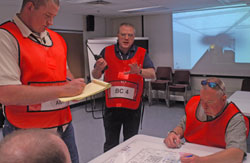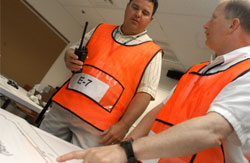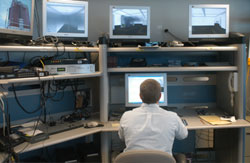Simulation Laboratory

Command and Control students participating in a commercial structure fire exercise.

Students reacting to the latest developments in a simulation exercise.

Exercise controllers running a simulation in the laboratory.
The Simulation Laboratory is designed to expand the knowledge, skills, and abilities of students in the Incident Management Curriculum by reinforcing lessons learned in the classroom through a series of practical simulation exercises. The laboratory provides command and control training for any type of emergency response at every experience level. The NFA and the Emergency Management Institute (EMI) share the facility and regularly conduct joint simulations as well as large scale, mixed media exercises.
The laboratory is configured to afford candidates "real-world" training in a variety of emergency situations encompassing incidents such as dwelling fires, commercial and large structure fires, catastrophic disasters and major emergency events, such as hazardous materials releases and mass casualty incidents. 3D computer models are used to provide visual clues, which are generated through the use of commercial off-the-shelf special effects, graphics, and animation software, and controlled through a standard personal computer by menu driven software. The goal of the simulation training is to provide the student with a variety of visual and auditory cues that will enhance the decision-making process in practical situations. This training provides realistic experience in the application of the principles of the National Incident Management System (NIMS) and conversancy with the recognition primed decision-making model of higher order cue-based decision-making.
Twenty-seven computer enhanced simulations used to support NFA Command and Control courses have been completed. Future plans call for joint transmission of NFA and EMI training to remote sites.

